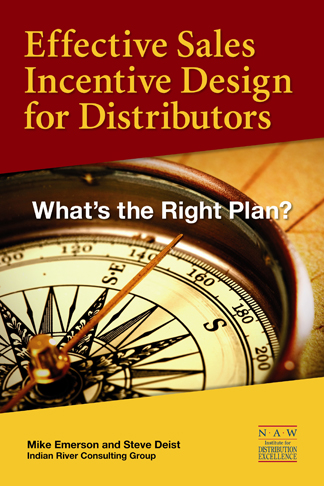The need for uniformity
An excerpt from the book Effective Sales Incentive Design for Distributors
by Mike Emerson and Steve Deist
 Many larger wholesaler-distributors are the product of multiple mergers and acquisitions of companies that used widely varying compensation programs. Even smaller distributors often have a legacy of highly autonomous branches with inconsistent plans. In some lines of trade, it is still not unusual for each individual sales rep to have an essentially unique personal pay plan. The resulting menagerie of different pay structures and formulae can be expensive to administer and difficult to automate. The variety also creates sales management challenges, as there are no uniform performance standards or expectations of behavior. The biggest issue is often political: “I just found out I make half of what Fred makes even though my territory is bigger and I hit my quota twice as often.”
Many larger wholesaler-distributors are the product of multiple mergers and acquisitions of companies that used widely varying compensation programs. Even smaller distributors often have a legacy of highly autonomous branches with inconsistent plans. In some lines of trade, it is still not unusual for each individual sales rep to have an essentially unique personal pay plan. The resulting menagerie of different pay structures and formulae can be expensive to administer and difficult to automate. The variety also creates sales management challenges, as there are no uniform performance standards or expectations of behavior. The biggest issue is often political: “I just found out I make half of what Fred makes even though my territory is bigger and I hit my quota twice as often.”
It is also pretty clear that having the right organizational structure is essential for ensuring that any plan is effective. We have seen many companies try to increase business development activity by paying higher rates on new business or tying bonuses to opening orders. But the incentive is unlikely to work if a rep’s territory is already large and he or she cannot offload some of their current duties onto someone else. The “sure bet” of a payout from servicing existing customers well will outweigh any potential upside from abandoning them for unknown opportunities. Wholesaler-distributors that have successfully used their sales force to increase business development have done so by changing their organizational roles and realigning sales territories, not just changing the pay plan.
Case study: when growth requires change
Our firm’s research and project experience strongly support these conclusions about organizational roles and realignment. An industrial equipment distributor we worked with provides an excellent example. When the company saw the need for a new sales compensation plan, its executive team started by reviewing the firm’s overall strategy. The company is a serial acquirer with a strategy to increase the “route density” of its field sales force. By offering a broader basket of products, reps could sell more to each customer, allowing the company to afford more reps in any given geography. Ideally, this creates a virtuous cycle in which more rep density increases customer intimacy, which leads to more revenue per rep, which, in turn, finances higher rep density. It is hardly an original concept, but few wholesaler-distributors have been able to pull it off. The biggest challenge with this strategy is the difficultly the field sales force faces in supporting a wide range of products. As the basket broadens, reps can no longer be technical experts on everything they sell. They are naturally uncomfortable in risking key accounts by trying to sell them something new and unknown.
This distributor realized that the key to successfully executing this concept was a holistic approach in which the strategy was supported by inside and outside technical specialists, dedicated industry experts, and comprehensive transaction support. This provided field sales reps with the resources they needed to be able to concentrate on cross-selling and opportunity identification. The company also implemented a new sales management system to measure and reinforce the reps’ new role and behavior. Finally, it realigned territories so that field sales reps had fewer but more strategically valuable accounts. Account assignments were made deliberately by management based on growth potential, not by sales reps choosing “buddy accounts” from the hundreds within their traditional patch of dirt. The strategy and structure changes were completed prior to the design of the new compensation plan, which was implemented in parallel with the sales management system and territory changes. In the first year of operation, the distributor’s sales increased by more than 30% -- substantially above the market, with no net increase in sales staff. Few of the field sales reps achieved their personal cross-selling goals, but the strategy has been sufficiently well executed to yield enviable financial results. The new roles and behavior have been fully cemented by the firm’s comprehensive implementation.
Although this particular project involved considerable work and analysis, the overall timeline (about four months) was only slightly longer than would be expected for a compensation-only project for a company of its size. The key point is that true alignment requires consideration of strategy and structure, not just compensation.
Excerpted from Effective Sales Incentive Design for Distributors by Mike Emerson and Steve Deist, published by the NAW Institute for Distribution Excellence. To order, click this link or call (202) 872-0885.













